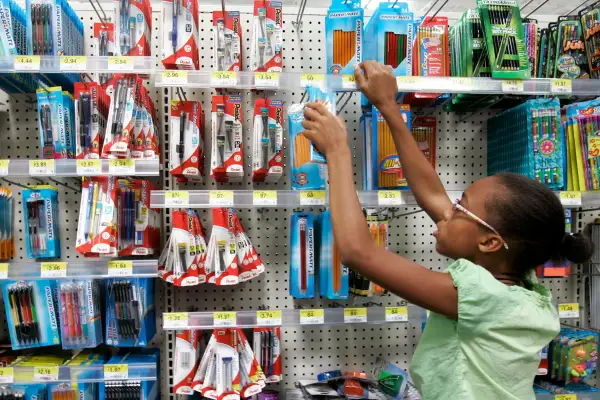Back-to-School Shopping Will Be More Expensive This Year

Back-to-school shopping is back — but don’t expect all the sweet deals you’ve been used to in the past.
The pandemic upended school shopping last year, but now that much of the U.S. population is vaccinated, students are headed back to in-person classes in the fall. And they're going to be loaded up with school supplies. Total back-to-school spending in 2021 is expected to reach an all-time high of $37.1 billion, according to a survey from the National Retail Federation (NRF).
It's not just that families are buying more back-to-school supplies this year. Thanks to shortages, shipping costs and more, your shopping cart may be a bit more expensive than you expect. Retailers are also aware of heightened demand from shoppers, so they may be less likely to offer steep discounts on things like crayons and backpacks compared to previous years.
“When costs go up, inevitably they get passed on to consumers,” says Alla Valente, a senior analyst at the research firm Forrester.
Here’s what you can expect as you set out to purchase those notebooks and lunch boxes.
Back-to-school supply shortages
Retailers are facing several hurdles when it comes to getting parents and students the supplies they need for the school season.
Transportation, including from China and other Asian countries, has become significantly more expensive. Retail giants like Walmart and Amazon are scrambling to nab space on shipping containers as they try to restock after pandemic-induced supply chain disruptions, the Wall Street Journal reported. Meanwhile, prices have also been increased due to mass delays after a huge shipping container got stuck in Egypt’s Suez Canal for six days in March. The incident took place right as many companies were trying to ramp up their supply chain after a rough 2020, Valente says.
“That really threw a wrench in their plans to make themselves whole again,” Valente adds.
NRF has heard from retailers that they’re planning to fly products in instead of shipping them, which is more expensive, and companies might not have a choice but to pass the cost on to consumers, says Katherine Cullen, NRF’s Senior Director of Industry and Consumer Insights.
While we’ve gotten somewhat used to dealing with shortages over the last year (remember the great toilet paper shortage of 2020?), it isn't making back-to-school shopping any easier. A global chip shortage — driven by several factors including the pandemic’s impact on supply chains and customer behavior, and government sanctions on Chinese technology companies — is impacting production on everything from cars to smartphones. That may make it tougher to find good deals on computers for students.
Students and parents will also be chasing after cleaning supplies, which grocery stores are already stockpiling, as teachers add these products to their shopping lists.
Our shopping behaviors changed during the pandemic
Consumers have also changed the way they approach their shopping lists, and it's impacting what's available to buy.
“We were so used to just going in and ordering what we wanted, and buying things because they were in stock or we could get them with two-day, three-day shipping,” Valente says. “Now, after last year, we’re doing a bit more bulk buying and a bit more just-in-case buying.”
Meanwhile, there may be more demand for technology as some parents are hesitant to send their children (especially those under age 12 and still ineligible for the COVID-19 vaccine) back to school or want to supplement schooling at home because of learning lost during the pandemic, Valente says.
How to save on back-to-school shopping
It’s not the time to procrastinate.
“Don’t wait until the last minute particularly for any essential school supplies” Cullen says. “Start early, give yourself time to shop around.”
It’s also best to not try to stock up on everything at once, but focus on the first-week essentials. You can go back for that extra box of markers in a few weeks.
And use retailers’ tools to your advantage, Cullen says. Check e-commerce sites and mobile apps to see which products may be unavailable online but can be bought in store, and if there are any special deals for picking up items in person.
More from Money:
7 Things That Are Getting More Expensive in 2021
Gen Z Is Rewriting the Rules for Personal Finance in Real Time. That's Good, Right?
